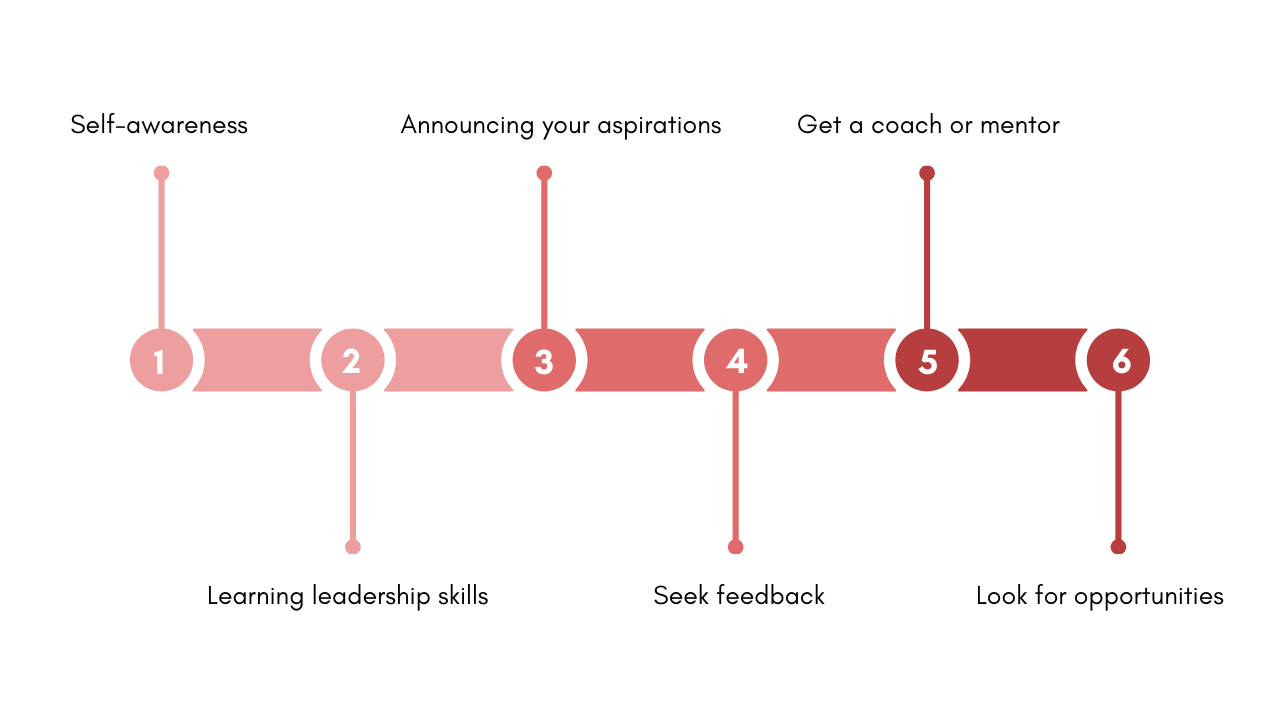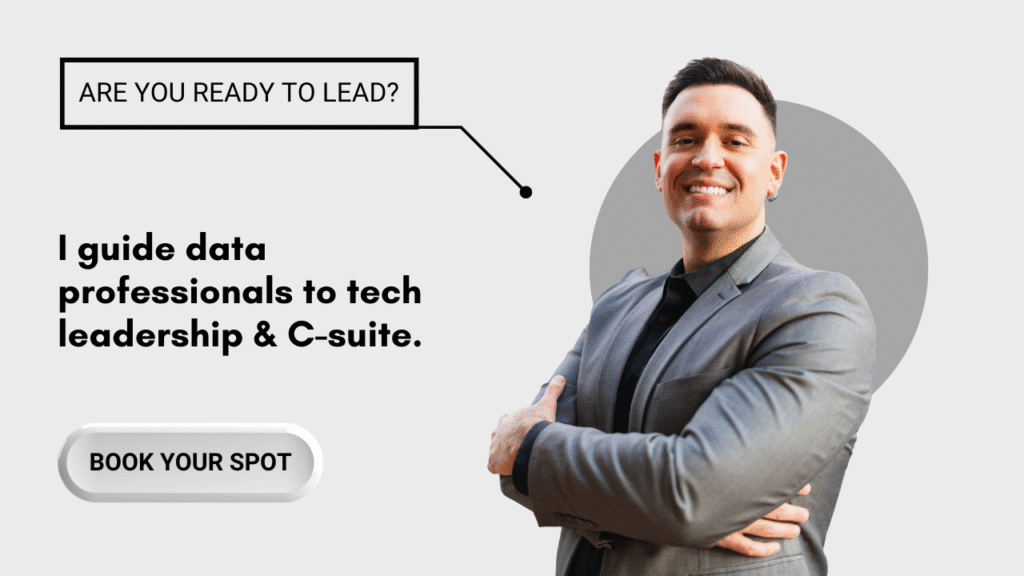Climbing the corporate ladder means stepping into management and leadership roles. Whether you’re from tech, marketing, data, or sales, pursuing a leadership role feels daunting. It’s a game that you have never played before, but want to.
If you’re afraid of messing up or unsure if you should pursue leadership or are firm in your decision but don’t know how to get your foot in the door, this guide is for you.
I’ve shared an adapted snippet of my process of getting a leadership role without experience that I deeply cover in my mentorship to guide my people on how to get a leadership position without experience. It’s an actionable guide that you can start implementing today. Let’s start.
How to get a leadership role without experience

Step 1: Self-awareness
The most important step that the majority miss: Looking within.
This self-reflection session will have 4 aspects: your why, your strengths and weaknesses, your leadership style and your role model. Take a pen and paper, and sit down in a peaceful environment with your favourite drink, and let’s reflect.
Your why:
Ask yourself these two questions
- Why do you want a leadership position, and why is it important to you?
- Do you really understand what leadership means?
You should be pursuing leadership for all the right reasons and not just because of a higher salary, shiny title and climbing the corporate ladder.
Your right reason(s) can be any of the following:
- You know your skills and expertise will be better utilised in a leadership role.
- You want to empower your team and bring the best out of them.
- You can create the right environment and systems where your team can thrive.
- Your vision and skills can benefit the company and your team.

Your strengths and weaknesses:
You are now aware of why you’re choosing this role and what you can bring to the table. The next step is to evaluate your skills. List down the transferable skills you have.
Think of the times when you demonstrated soft and interpersonal skills. You might have trained a new employee, led a small project, empathised with a co-worker or handled a difficult situation.
Now, list down your weaknesses, the soft and interpersonal skills you need to develop. An easy way to determine your current position is to take a leadership assessment.
I’ve designed this quick quiz based on the questions I ask my mentees to evaluate them on 5 key leadership areas:
- Strategic thinking
- Team management
- Effective communication
- Change management
- Decision making and problem solving.
The quiz will help you identify your strengths and weaknesses and give you actionable steps to develop them.
Your leadership style:
There are multiple leadership styles. All of them are equally important and fit in specific situations.
Though leaders adapt different styles in different scenarios, everyone has a dominant leadership style based on their personality and team dynamics. You need to identify your dominant style(s).
Your role model:
This one is optional. If you admire a manager or leader from your current or past company, consider them your role model. Observe them, analyse their actions, understand their mindset and embody their style with a pinch of you.
Step 2: Learning leadership skills
Once you’re clear on your direction, it’s time to begin your learning journey. Pick one skill at a time, learn it and start implementing it (more on that in a while). Refer to YouTube content and courses for learning.
If you’re not sure where to start or what skills you need to develop, check out my detailed guide on how to effectively build leadership skills.
If you’re from a technical background like me, project management, emotional intelligence, effective communication, and conflict management skills will need your attention the most, as they are not always our cup of tea.

Step 3: Announcing your aspirations
Find someone higher in hierarchy, let them know your career goals, and show that you’re eager to learn from them. And don’t shy away from spreading the word in your circle, too.
After learning and demonstrating your leadership capabilities, sharing your aspirations brings everything full circle. Your company is already witnessing your skills, and once you mention it, it shows that you’re ready to take more responsibility.
If you do it right, your name will pop up in their mind when there’s an opportunity. Steps 3 and 4 position you to attract opportunities and build your personal brand as a leader.
Step 4: Seek feedback
When you start practising your skills, find a way to receive feedback. It can be from your manager, boss, your role model, or a colleague.
Or it can be as simple as reflecting and analysing the event and figuring out what went right and what you can improve.
Feedback not only helps you improve but also gives you the courage to continue showing up. Hearing your efforts are making an impact will give you the necessary dopamine hit to keep going.
Step 5: Get a coach or mentor
If you’re finding all these steps complex and difficult to navigate, or if you are someone who prefers a structured learning route rather than freestyling yourself, mentorship and coaching will be your best options.
For some, this career growth comes easy, but for many, it’s a mountain they feel uncomfortable climbing alone.
Mentorship can be the support and guidance you need. A mentor not only brings their own experience but also the lessons from hundreds of others they have guided.
While doing-it-yourself leaves you overwhelmed with an improper structure, mentors have the frameworks and structures in place to strategically move you through every step of your career growth.
In both cases, you will be investing in yourself. Mentoring requires financial investment, while DIY-ing, you invest your time, energy and mental power.

Step 6: Look for opportunities and shoot
If you successfully complete the first 5 steps, opportunities will come your way. It can be an open position within your company, a project lead, or counselling and training a new hire. Be ready to step up when offered to lead.
If you apply for a position, prepare for the interview. Put together answers to common leadership questions.
Pro tip: If you’re planning your career growth in your current company, ensure you have good ties with your team. A leader is the one people naturally follow. If you aren’t trusted or liked by your team, you might be seen as a boss and not a leader.
A strategic leap to a leadership role without experience
Waiting to be offered the leadership role isn’t the best idea. Your career growth is “your” responsibility. You have to put in effort to develop the right skills, practice them, and position yourself to receive opportunities.
If you belong to the data industry and found this article helpful. Check out my mentorship programme. It’s a 8-week one-on-one journey that will prepare you to get that leadership role without experience and having full clarity and confidence.
I share my processes and frameworks that made me and multiple others jump from technical roles to leading departments.









